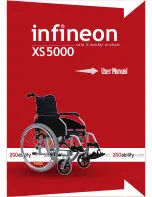
ANSI = American National Standards Institute, RESNA =
Rehabilitation Engineering and Assistive Technology
Society of North America.
This wheelchair has been dynamically tested in a forward-facing
mode with the specified crash test dummy, which corresponds
to a person with a weight of over 300 lbs (136 kg) restrained by
Both pelvic and shoulder belts in accordance with ANSI/RESNA
WC-4:2017, Section 19. Both pelvic and upper torso belts
should be used to reduce the possibility of head and chest
impacts with vehicle components.
6.10 Positioning the Wheelchair in the Vehicle
WARNING!
Risk of Injury
-
This wheelchair MUST be in a forward facing
position during travel in a motor vehicle.
-
The recommended clear zones for wheelchair
seated occupants restrained by both pelvic and
upper torso belt(s) and only by a pelvic belt are
shown in the diagrams and described below.
-
Frontal Clear Zones (FCZ) need to be LARGER when
upper torso belt(s) are NOT used.
WARNING!
Risk of Injury
-Vehicle interior components that cannot be removed
from the clear zones or that are near the wheelchair
occupant may contact the wheelchair occupant's
head during side-impact collision or vehicle rollover.
These components should be padded with material
that complies with FMVSS201.
The rear clear zone of 20 inches (500 mm) is measured from
the rearmost point on an occupant’s head.
The frontal clear zone is measured from the frontmost
point on an occupant’s head and is 26 inches (66 cm)
with pelvic and upper-torso belt(s) and 37 inches (94
cm) with ONLY a pelvic belt.
The frontal clear zone may not be achievable for wheelchair-
seated drivers.
The estimated seated height (HHT) from the ground or floor to
the top of the wheelchair-seated occupant’s head ranges from
approximately 47 inches (119 cm) for a small adult female to
about 61 inches (155 cm) for a tall adult male.
60101876-C
43
6 Transport - ANSI/RESNA WC-4 Section 19
Summary of Contents for Captain's Seat
Page 74: ...Notes ...
Page 75: ...Notes ...
















































